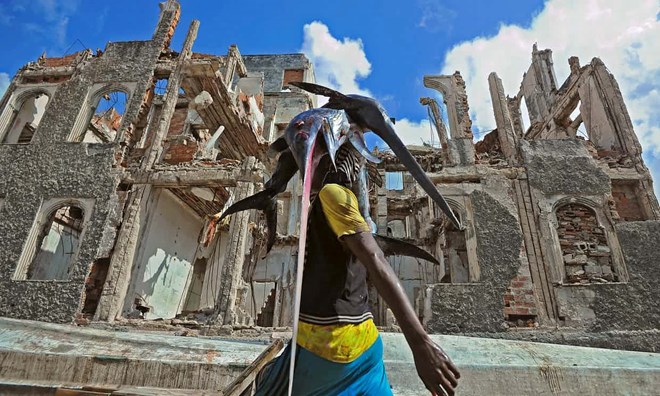
Wednesday May 23, 2018

A fisherman carries a sailfish past buildings destroyed in the warfare. Photograph: Mohamed Abdiwahab/AFP/Getty Images
FIve years ago, Yusuf Shegow visited the ruins of the once-grand Al-Uruba hotel overlooking the Indian Ocean on Mogadishu’s waterfront. His grandfather had worked at a nearby hotel in the 1970s, and shared stories with Shegow of the diplomats and dignitaries who stayed there on frequent visits to the country then known as the “Switzerland of Africa”.
After decades of civil war, Al-Uruba’s arched windows and white plaster facade were in tatters. The entire fourth floor was gone, levelled by mortar fire.
For Shegow, a recent graduate of the Manchester School of Architecture, “buildings were an education” that taught him about a country he left for the UK when he was a child. They connected him to the stories of his parents and grandparents. “There were roads and buildings as good as anywhere else,” he says. “It could have been one of the biggest cities in Africa.”

Some find it difficult to reconcile fond recollections of Mogadishu with modern images of ruined buildings. Photograph: John Moore/Getty Images
Shegow is the founder of Somali Architecture, a project that digitally recreates buildings and monuments from Mogadishu’s prewar age, presenting a positive vision of a city that was once a flourishing economic and cultural capital – and could be again. Their work includes an ambitious set of 3D digital models of prominent buildings now largely destroyed, created by Shegow after years of archival research. There’s also a popular Instagram account featuring hundreds of images of the city’s former grandeur.
“By focusing on how the city used to be, we’re also asking where the city is going now,” he says. He hopes the 3D models could serve as a guide for future development, reminding planners of the city’s architectural heritage.
Shegow’s project is only the latest initiative that uses digital technology to preserve and recreate the architectural splendour of the past. A project inspired by the late Syrian activist Bassel Khartabil and supported by the Institute of Digital Archaeology (IDA) and Unesco had volunteers take 3D photographs of Palmyra before it fell to Islamic State fighters in 2015. The ancient city’s Arch of Triumph was subsequently rebuilt off-site based on 3D models created by the database of images, with oversight from the director of the Palmyra museum.
According to Roger Michel, director of the IDA, the purpose of these projects transcends restoration, building up communities and involving people in a shared cultural history. “These models are useful in bringing things back from the past for scholarship and restoration, but they become monuments in their own right,” Michel says.

Mogadishu was once a flourishing economic and cultural capital but much of its architectural heritage has been obliterated by war. Photograph: Goran Tomasevic/Reuters
The Somali project does not have the benefit of 3D cameras; the damage in Mogadishu is already done. Shegow and his team rely heavily on archival and crowdsourced photographs. An appeal for such images has drawn responses from across the vast global Somali diaspora, estimated to be over a million people. Most left the country in the war-torn 1990s.
Madina Scacchi, an Italian-Somali architect based in Rome, has never set foot in Somalia. She found it difficult to reconcile her parents’ fond recollections of their lives in Mogadishu with modern images of ruined buildings. “You hear such nice stories about Mogadishu, but I couldn’t see the things my parents saw,” she says. “All you see is destruction.”
Scacchi found Somali Architecture’s Instagram account through a Canadian-Somali friend. Intrigued by the 3D models, she contacted Shegow, eventually joining the team as a volunteer. For her, the project provides “a way to feel less separation” from her roots.
This energising of young Somalis comes at a time of tentative hope for the city and the country. While government forces regained full control of Mogadishu in 2012, terror attacks remain a serious threat. Last October’s truck bomb by Islamist extremists killed more than 500 people and dented confidence that stability was returning.

A fishing harbour in Mogadishu. ‘You hear such nice stories about the city, but I couldn’t see the things my parents saw,’ says one Somali-Italian architect. Photograph: Alamy
But Somalis who fled violence and drought in past decades continue to arrive home from around the world. In recent years China and the US have re-established diplomatic posts in Somalia, while the UK constructed an embassy in Mogadishu, all preludes to what the country hopes will be a return of foreign investment – and a ramping up of reconstruction.
“The diaspora are coming back now, and we need a cohesive idea of where the city is going,” Shegow says. Scacchi fears that the building happening now in Mogadishu is not informed by an appreciation of the city’s rich architectural history. “In our modest way, we are trying to change that,” she says.
The group is currently preparing to show their work at architectural forums, while building their network of contributors. They are still hundreds of buildings short of a city. “My grandfather’s hotel, the Juba, I want to model that,” says Shegow. “But there just aren’t enough images. Not yet.”